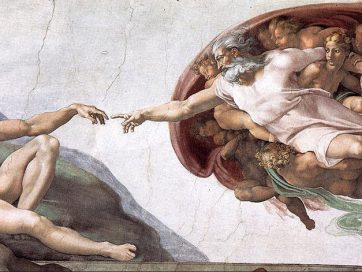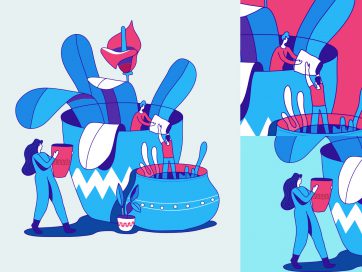
Of the Fortune 500 companies in 1955, only 12% still exist sixty years later. Or, more precisely, 61 companies. The other 439 suffered one of three fates: they either went bankrupt, were acquired by, or merged, with other companies, or shrunk in size so as to no longer be among the top 500. Each of their stories, with greater or lesser degree of drama and melancholy, inspires us to reflect on the gears of this grinding mill called time and its effects on the dynamics of companies past and present, and leads us think of strategies to guarantee the future.
Werner Sombart and Joseph Schumpeter call the demise of corporations “creative destruction,” implying the notion that capitalism destroys and rearranges preexisting economic orders – and, by this process, devalues existing wealth to pave the way for a new type of wealth. These visions, clearly influenced by Marxist ideology, have been debated by scholars throughout the latter half of the 20th century.
Therefore, instead of analyzing the survival of companies with an ideological bias, I’d rather observe everything from a biological viewpoint. That is, I’m more interested in assessing which Darwinian forces of “natural selection” allowed only 61 companies out of 500 to remain strong over the sixty most disruptive years of human history.
When we examine the list, we clearly see that the raison d’être of most survivors is technological innovation. In companies such as 3M, Abbott, ATT, Avon, Boeing, CBS, Coca-Cola, DuPont, GE, GM, IBM, Johnson&Johnson, Kellogg, Kraft, Lear, Lockheed, Monsanto, PepsiCo, Pfizer, Procter and Gamble and Whirlpool, the process of discarding the outdated and investing in the discovery of new paths is part of their DNA. In all of them, what remains constant is the quest to do more and better, to stay ahead of one’s competitors. In other words, these companies incorporate creative destruction into their processes as a way of pursuing evolution.
This evolutionary drive is fully aligned with Charles Darwin’s findings: more adaptable individuals stand a better chance of surviving and perpetuating their genes through their descendants, who are born better adapted, than those who cannot adjust to the environment. Darwin argued that the evolution of species occurs through mutations that, over generations, eventually define themselves as adaptive traits to the environment. That is why felines living in different environments have different coats, jaws and habits, even if they share the same ancestors. Lions, tigers, jaguars, pumas, ocelots and lynx are clearly related, but each one adapted to a distinct environment. The same happened to the companies that persisted on the Fortune 500.
If we look closely, companies in the same industry had to keep in constant evolution so as not to be swallowed by their direct competitors. For instance, in the realm of pharmaceuticals, Abbott, Bristol-Myers Squibb and Pfizer are on the list. Each had to move fast to fight off competitors and, because of this, they continued investing in the research and development of new products. This ongoing evolutionary race enabled them to perpetuate themselves in the list.
But even in seemingly more commoditized sectors, such as the food industry, a competitive environment is a healthy thing and helps companies to remain among the most affluent and powerful. In Fortune’s list, companies such as Campbell Soup, Coca-Cola, Hershey, Kellogg, Kraft Foods, and PepsiCo have carried on well over the last 60 years – all of them facing intense competition, but always closely integrated with their customers. In order to survive, each one perfected their capabilities and this gave them the necessary strength to endure.
An example of this dynamics is Coca-Cola, the giant maker of syrup-based carbonated drinks that realized, at the turn of the millennium, that there was a trend toward healthier beverages, such as teas, juices, coconut water and waters in general. Soon, in several countries, this MNC began to acquire companies that manufactured the beverages that people wanted to drink and employed its powerful distribution network to further the trend toward healthy drinks, establishing itself in niche markets where it did not compete or had only a discreet presence. Coca-Cola thus changed the beverage market landscape and created a new correlation of forces. This kind of mutational attitude is recurrent in companies that managed to remain market leaders over the past six decades.
In the aviation industry, where technological evolution is the key determining factor of a company’s success, Boeing, Lear, and Lockheed Martin stayed on the list. Each sought to deepen their skills to meet specific demands. This segmentation is often found in nature. Species adapt in order to become more efficient in their respective habitats. Brown bears know how to climb trees, polar bears are excellent swimmers, pandas eat bamboo. More than merely possessing these abilities, however, each species adapted its biological systems both to collect food more efficiently and, internally, to better assimilate the nutrients that each ecosystem provides. This is precisely what happened with companies in the aviation industry. One focused on large passenger planes, another on executive jets, and the latter on turbines.
Included in the Fortune 500 since 1955, IBM is the most iconic example of a company that has experienced constant DNA mutations. This relates to the dynamics of the IT industry itself, which is ruled by the swift evolutionary leaps that have come to be described as Moore’ Law. In 1965, Gordon E. Moore, then chairman of Intel, predicted that the number of transistors in a chip would double every 18 months while production cost remained the same. The prognosis came true and forced every technology company in the world to build R&D muscle to keep up with this frenzied pace of growth.
But this accelerated evolutionary tempo eventually transcended the frontiers of the IT industry. As in natural ecosystems, where a change in the habits of a single species impacts the whole, in the business world a company’s evolutionary change will affect companies in very different sectors.
When Apple created iTunes and, later, the AppStore, it changed the entire landscape because, by enabling a straightforward way to sell applications, it also made the developers’ business feasible. This change in the landscape impacted the entire technology market and resonated in industries far away. For instance: in theory, someone who makes a living by selling hot dogs would be largely unaffected by what app developers do, right? Wrong. For as soon as a developer created an application allowing people to order food the hot dog distribution process changed. If the owner of a hot dog food truck does not computerize his/her business or fails to keep up with the market changes, all sales through the application will be lost. Furthermore, app-driven sales require hot dog sellers to adapt their product for delivery. They might have to send side orders and garnishes in separate containers or adjust their recipes for transportation. That is how a mutation in applications caused the evolution of the hot-dog.
Apple, by the way, is perhaps one of the most telling examples of how mutant corporate DNA can change the marketplace. For instance, when Apple launched the iPod, it changed its immediate market, that of electronic music players; with iTunes, however, it also changed the way music is distributed, impacting the hitherto all-powerful record companies – not to mention the changes in consumer behavior that ensued from this release.
Then, five years later, Apple launched the iPhone, which is an amalgam of cell phone, internet access channel, iPod and camera. With it, Steve Jobs changed the mobile phone market, hastened the need for mobile operators to provide good internet service, struck again at the music market, impacted the photography market, increased opportunities for social networks and extended possibilities for app developers. All these changes brought about revolutions in consumer behavior and continued to transform the landscape of a broad range of markets. For instance, cameras connected to social networks have altered how fashion information is disseminated. This changed the dynamics of the editorial offices of fashion magazines, enhanced the influence of bloggers and revised the allocation of advertising budgets. And the changes continue: even as a fashion show is still taking place, proposals can be seen and absorbed by designers and makers of ready-to-wear clothes, and this new agility has forever altered the production cycle of the fashion industry.
Disruptive launches like the iPhone, capable of changing several markets, also contribute to the fusion of different ecosystems. Today, the photography ecosystem is linked to telephone ecosystem, while news production and entertainment consumption have become part of the same ecosystem. In the natural sciences, a transitional environment between different habitats is called an ecotone, which also ends up having a peculiar population. Today, thanks to all these constant changes, more and more activities take place in the ecotone and must remain in constant adaptation.
An example of a company that feels at home in the ecotone is Netflix. The content download business has not only driven from the market a giant rental company like Blockbuster, it also hit the pay-TV and even the content production markets. When Netflix began developing its own content, it altered a landscape that had been populated for more than a hundred years by giants such as Warner, Fox, Universal and Disney, and where the most recent addition had been HBO’s arrival two decades earlier. Ecosystems have a clear law: when a new animal is introduced, it usually has no predators, allowing it to quickly spread until its place in the food chain is consolidated. We can see here clearly what mutants have done to the market of content production.
But the impacts go even further and also affect the advertising market, provoke changes in the target audience of various products, and alter the correlation of forces in markets far removed from the art & entertainment world, e.g., that of providers of broadband access to the internet.
All this shows that mutations change business ecosystems and that the new environment is conducive to ever-greater evolutionary leaps.
One must bear in mind that individuals of the same species are 99% alike. All of their differences are in the remaining 1%. This is the territory where mutations occur and it is on account of them that we are unique, special and better equipped to face a changing environment. But it is important to remember that changes are always part of a larger system and must have a very clear purpose and relevance. In the absence of this, a company runs the risk of its “mutation” not working.
In light of the nonstop acceleration of the evolutionary process that society, markets and companies have been undergoing since Moore made his prediction, one can clearly see that companies that allow creativity to flow tend to be precisely those that manage to remain successful over decades. A good example is General Motors, a company that has remained on the Fortune 500 list since 1955. Despite being a global giant, the automaker adopted a number of internal procedures that empowered employees at various levels, while also investing heavily in research, development and design. To better capture inputs on consumer desires, Ed Welburn, who was the automaker’s Vice-President of Global Design from 2003 to 2016, set up seven design centers around the world – including one in Brazil, specialized in compact cars. His aim with decentralization was to eliminate bureaucratic barriers and cultural distortions, and thus optimize the creative talent of the company’s teams. He explained in an interview that each culture has its own vision of design deriving from its distinctive experiences, and that people from different cultures might not understand the local proposals. Brazil, for instance, does well in compact cars, but its proposals may not suit the taste of Americans, who prefer bigger cars. And the opposite is also true; certain international standards are not particularly appreciated by Brazilians. By comparing oranges with oranges and apples with apples, and assigning each expertise its due value, Welburn both protected the ego of the talents of the various teams and kept them motivated.
Concern with the employees’ overall mood is critical for companies to maintain their creative energy and enthusiasm for innovation, and to continue renewing themselves internally. This helps to retain talents, which is key to preserve the company. When this “environmental” issue is not heeded, talents will behave like animals do and will leave that habitat to seek greener pastures and more abundant water elsewhere. The flight of the best minds is one of the most serious problems a company can face, because it amounts to an impoverishment of its creative assets. Companies that don’t strive to retain their best talent end up undergoing “reverse Darwinism,” when the best and most capable leave and the organization gets stuck with less motivated and more complacent employees who are never going to struggle for innovation or lead evolutionary leaps.
Many of these executives do act like this out of malice; they simply believe in an outdated archetype of the corporate professional. In The Little Prince, the classic book by Antoine de Saint Exupéry, the boy visits the planet of the Businessman, where he finds a grumpy fellow who, in an infinitely repetitive movement, did nothing more than count and recount things which he didn’t exactly know what they were – actually, they were stars. This is the type of “businessman” who destroys the creative core of a business and prevents its evolution. Today, the corporate structure requires people who are committed, to be sure, but also proactive and capable of seeing the world more comprehensively. The Little Prince told the Businessman that he thought it was important to be useful to the things one owns. There lies a great message for all professionals: it is important to be useful to one’s job, it is essential to help one’s company in its evolutionary process, which will always be disruptive.
To a greater or lesser degree, every mutation creates some imbalance in the ecosystem, and this requires companies to take on the responsibility of combating imbalances. Let’s say a company launches a touchscreen phone and changes the market with it. In order to correct this imbalance in the ecosystem, its competitors quickly develop models capable of competing with that innovation.
The best way to avoid being taken aback in a situation such as this – which actually happened in the phone market when Apple launched the iPhone – is for business teams to strive to identify the most relevant market trends. However, it is important here to distinguish between trend and fashion. Fashion is something material, a product that consolidates aesthetic references. A trend has a behavioral root and is based on what people feel as relevant in their lives. Trend cycles are longer and their scope is much broader than the aesthetics of objects – so much so that they may even alter worldviews.
For example, at some point, the health and fitness trend met the trend to reduce carbon emissions into the atmosphere and, as a result, people became interested in deploying bicycles as a means of transportation. As more and more cyclists appeared, cities had to adapt and bike lanes were built, which in turn encouraged more people to pedal instead of driving. It should be noted that trends such as this one affect multiple business ecosystems: bicycle manufacturers, distributors of vitamin supplements that improve aerobic performance, sneakers and backpack design, isotonic drinks production, parking spaces for bicycles, accessories such as helmets and knee pads, medical clinics specialized in orthopedics, sunscreens, waterproof clothes – in short, they create a wholly new consumption landscape.
Another trend that has been consolidating in several industries is “uberization.” With the broad dissemination of applications, broadband internet access and the public’s rapid adherence, several collective and collaborative business models have emerged. Coworking spaces, Airbnb, Uber and public bicycles are some examples that prove that mutations are leading the high-speed transformation of ecosystems.
References:
- https://www.aei.org/publication/fortune-500-firms-in-1955-vs-2015-only-12-remain-thanks-to-the-creative-destruction-that-fuels-economic-growth/
- https://en.wikipedia.org/wiki/Creative_destruction







